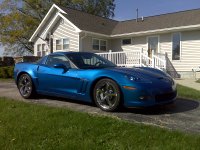I've always liked to listen to folks who get into arguments over what is or is not a sports car. There are those who say that if your car weighs over a ton, has air conditioning, isn't convertible, has greater than a 1600 cc engine, or a trunk that can carry anything larger than a spare it is NOT a sports car. I tend to be in that crowd even though I owned a Datsun 240Z and called it a sports car on a regular basis.:confused2: The true sports car in that line was probably the Datsun 1600. The later Datsun 2000 was pushing the envelope on a true sports car.
I've been to a lot of SCCA races and watched the Camel GT series where they threw several classes of cars onto the track at the same time and watched them race in a close approximation of the freeway at rush hour. I remember one year they even brought in a couple of NASCAR cars just so the crowd could get used to the strong smell of overheating brakes and watch cars running as much off the track as on the track.

:laughing: I never saw a Corvette that wasn't passed by the Porsches and BMWs on a regular basis. They just didn't have the braking and turning ability of the smaller cars. Of course, the last race I attended was in 1979, so a lot has happened since. Frankly, I think the consumer market suddenly expected so many comforts from their "sports cars" that they morphed into much bigger luxury two-seaters so every race driver wanabe could own one and still haul the kids to school and load a weeks worth of groceries into the trunk.

Jim, did you read this article, that I linked up above?
Corvette Racing History:
Corvette Racing History: The Making of a Performance Icon
They competed quite well, especially on some tracks, in their respective classes.
The 1970's with smog and bumper regulations hurt them (just as it did the venerable MGB and MGC), along with the changing consumer demands. I never cared for Gen 3 Corvettes (1970's through 1983), but otherwise they've impressed me with what got for your money -- if they were "spec'ced" with the right options.
My old '62 that I bought in 1970 had been spec'ced with heavy-duty brakes (larger finned drums, metallic shoes, etc.), steering and cooling for just that purpose, along the the 327-340HP, Borg-Warner wide-ratio T-10, 3.70 rear axle with posi-traction, etc., in addition to the sway bars, axle straps, etc. Not a dragster with that gearing for sure (especially with the wheel hop), but if you'd run it up near red-line in 1st and speed-shift into 2nd, it would torque-twist and lift the left front tire about 12" off the ground, then you could run it up to 80 MPH in 2nd, chirp the tires shifting to 3rd and go on up to 120MPH at red-line in 3rd gear. I never did have the guts to see what it would do in 4th, though I saw 148MPH registered on the speedo once -- at 4800 RPM. It red-lined at 7200, but would have never redlined in 4th with that gear ratio. I'm guessing it would do somewhere around 165 or so, before aerodynamics consumed the available power, but I'd have wanted that to be on a banked track somewhere...
Heavy understeer, but with enough torque to break the rear loose and drift through corners... then accelerate like crazy on the straights -- never using 4th gear unless it was a long straightaway. Tires that would handle that power were the real weakness, IMO, moreso than the suspension. The 63-67 models handled much better with their IRS rear-end, better aerodynamics, etc. and the 70-series tires were starting to come widely available, though still bias-ply...
They certainly didn't handle well by today's standards, but what did?


